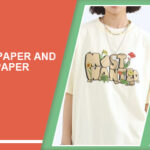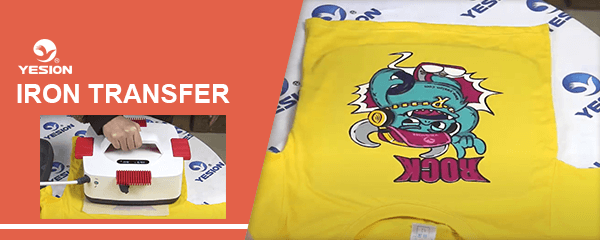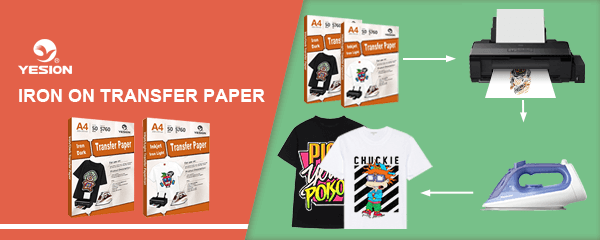
Inkjet transfer paper and laser transfer paper
2023-09-22
National Day Holiday Notice 2023
2023-09-28Iron-on transfer paper, also known as heat transfer paper, offers a convenient way to transfer designs or images onto fabrics or other surfaces. Like any product, it has its pros and cons. Let’s explore them:
Pros of Iron-On Transfer Paper
Easy to Use: Iron-on transfer paper is relatively simple to use, making it accessible to beginners. You can easily print your design onto the transfer paper using a regular inkjet printer and follow the instructions for transferring the design onto fabric or other surfaces using an iron or heat press.
Versatility: Iron-on transfer paper can be used on a variety of fabrics, including cotton, polyester, and blends. It allows you to create custom designs on T-shirts, tote bags, pillows, and more. It also works on other surfaces like wood and ceramics, expanding its applications.
Cost-Effective: Iron-on transfer paper is generally affordable, especially when compared to other printing methods like screen printing. It offers a cost-effective way to create personalized or custom-designed items without the need for expensive equipment or professional services.
DIY Flexibility: With iron-on transfer paper, you have the flexibility to create your own designs or images and transfer them onto fabric or surfaces at your convenience. You can experiment with different designs, colors, and styles without relying on pre-made options.
Cons of Iron-On Transfer Paper
Limited Durability: Iron-on transfers may not be as durable as other methods like screen printing or embroidery. The transferred design can fade, crack, or peel over time, especially after multiple washes. To maximize longevity, proper care instructions should be followed, such as washing garments inside out and using gentle cycles.
Texture and Feel: Iron-on transfers can alter the texture and feel of the fabric, creating a slightly raised or stiff area where the design is applied. This can be noticeable, especially on garments with large or intricate designs.
Limited Color Vibrancy: The color vibrancy of iron-on transfers may not always match the original design printed on the transfer paper. The colors can appear slightly duller or different after the transfer process, depending on the fabric and the quality of the transfer paper used.
Design Limitations: Iron-on transfers are best suited for simple or medium-complexity designs. Highly detailed or intricate designs may not transfer well and may lose clarity or sharpness during the process. Additionally, the size of the design may be limited by the dimensions of the transfer paper.
It’s important to consider these pros and cons when deciding whether to use iron-on transfer paper for your specific project. While it offers convenience and affordability, it may not provide the same level of durability and professional finish as other printing methods.
Two types of iron-on transfer paper by YESION
YESION offers two types of iron-on transfer paper for inkjet printers: Inkjet Light iron on Transfer Paper and Inkjet Dark iron on Transfer Paper. Here’s an overview of each type:
Inkjet Light iron on Transfer Paper: This transfer paper is designed for use on light-colored or white fabrics. It allows you to transfer your designs, images, or text onto light-colored fabrics using an inkjet printer. The paper is coated with a special layer that helps the ink bond with the fabric fibers. After printing your design, you can use a heat press or a household iron to transfer the design onto the fabric. The result is a vibrant and durable image that can be washed and worn.
Inkjet Dark iron on Transfer Paper: This transfer paper is specifically designed for use on dark-colored fabrics. It allows you to transfer designs onto dark fabrics using an inkjet printer. The paper is coated with a white or opaque layer that provides a solid background for the printed design, making it visible on dark backgrounds. After printing your design, you can use a heat press or a household iron to transfer the design onto the fabric. The opaque layer prevents the fabric color from showing through the design, resulting in vibrant and opaque images on dark fabrics.
When you use these two transfer paper, It’s important to follow the specific instructions provided by YESION factory for proper printing, cutting, and heat transfer techniques to achieve the best results.
Before using the transfer papers on your final project, it’s advisable to perform a test print and transfer on a small fabric swatch to ensure the desired results and to familiarize yourself with the process. This will help you adjust settings, temperatures, and pressures as needed.
Wholesale heat transfer paper, YESION is your most reliable supplier. If you are interested in any of our products, please do not hesitate to contact us anytime.
Related:
The best heat transfer paper: Your Ultimate Guide for 2023
Inkjet transfer paper and laser transfer paper




